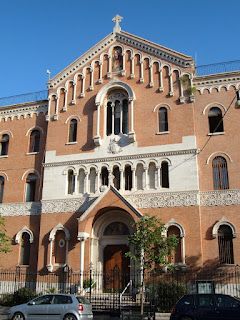The Church of Saint Susanna at the Baths of Diocletian (Italian: Chiesa di Santa Susanna alle Terme di Diocleziano) is a Roman Catholic parish church located on the Quirinal Hill in Rome, Italy. There has been a titular church associated to its site as far back as AD 280. The current church was rebuilt from 1585 to 1603 for a monastery of Cistercian nuns founded on the site in 1587, which still exists there.
Religious associations[edit]
American national church[edit]
After World War I, the Paulist Fathers, founded in New York City in 1858, had grown to such an extent that they felt the time had come to seek approval of their religious institute from the Holy See, in order to be able to work throughout the worldwide Church. They also wanted to establish a Procurator General there to coordinate their work with the Vatican. To this end, the Superior General of the Society, the Right Reverend Thomas Burke, C.S.P., went to Rome in January 1921 to meet with Pope Benedict XV for this. During this trip, they first noticed Santa Susanna, as it was adjacent to the American Embassy to Italy at the time. Its location made it of interest to the Americans.[7]
The Paulists opened the office of the Procurator General in the city that following spring, headed by Thomas Lantry O'Neill, C.S.P. In the meantime, Burke's brother, also a member of the Society, had approached President Warren Harding to make him aware of their interest in making use of the church to serve the growing American population of Rome. Harding made a request for this to the Apostolic Delegate to the United States, Archbishop Giovanni Bonzano, during the course of a meeting in June. Bonzano transmitted the request to the Vatican Secretary of State, with the recommendation that it be granted as a gesture of good will to the United States.[7]
In December 1921, Pope Benedict XV authorized the Paulist Fathers to administer Santa Susanna as the national church in Rome for the American residents of Rome and visitors from the United States of America. The abbess of the monastery gave the keys to the church to the new pastor on 1 January 1922. Cardinal William Henry O'Connell of Boston presided at the first public Mass for the American community of the city on 26 February 1922.[7]
The cardinal who held the title to the church had died during the summer of 1921, leaving the church with no legal owner under Italian law. At the same time, electrical lights were installed in the church, to which Americans were accustomed but Roman people found shocking. The Ambassador of Romania also claimed the church as a national church for the people of his country. The ownership issue settled at the end of 1924, when Bonzano, the former Apostolic Nuncio and by then a cardinal himself, requested a transfer of his title to this church. Once that was accomplished, he appointed O'Neill as the Rector of the parish.[7]
From 1958 to 1985, the cardinal assigned to Santa Susanna as his titular church has been the Archbishop of Boston. Bernard Francis Law remained the titular cardinal until his December 2017 death, though he resigned as archbishop in 2002 in the wake of the sexual abuse scandal in his archdiocese.
Since August 2017, following a campaign by the Cistercian nuns who had maintained a presence at Santa Susanna since 1587, the American expatriate community relocated its national church to San Patrizio.[8]
https://en.wikipedia.org/wiki/Santa_Susanna




